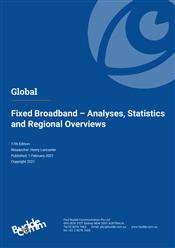Global Fixed Broadband - Analyses, Statistics and Regional Overviews

Last updated: 1 Feb 2021 Update History
Report Status: Current
Report Pages: 64
Analyst: Henry Lancaster
Fixed broadband development becomes important for 5G globally
During the past two decades there have been considerable efforts undertaken by governments and national telecom regulators to ensure that their countries' economic growth is underpinned by capable broadband infrastructure. The success of national policies has been variable, but the scale of investment and the manner in which the development of fibre infrastructure has been encouraged has been significant during the last five years or so.
The ongoing pandemic has also focused the attention of telcos on the need to ensure that telecom infrastructure is robust, while in the popular imagination fixed-line broadband has become an essential service for home working and home schooling. The increasing dependence on home internet services has led to significant growth in the number of subscriptions in many markets. It has also supported the use of associated services within the digital economy, such as e-payments.
Improved fibre-based broadband has also expedited the fall in the number of DSL connections in some regions, notably Europe and North America, as customers are migrated to fibre. The cable broadband sector has proved more resilient as customers are able to take advantage of cablecos' investment in DOCSIS3.1 technology.
In addition, fibre-based infrastructure is supporting the complex requirements for the transition to smart telecoms, incorporating smart grids and smart cities. It is also evident that such infrastructure is pivotal in forming the backbone for 5G infrastructure.
From a global perspective, the various regions and countries can vary markedly in terms of fixed broadband development. Overall, Asia continues to be a leading region, not only in the roll-out of broadband infrastructure, but also in promoting and applying the increased use of broadband to facilitate digital economies. Asia also continues to be the dominant region globally in the take-up and availability of FttP infrastructure, though there are market differences within the region itself.
The development of fixed-line broadband markets in Africa continue to be hampered by the lack of fixed infrastructure in rural and semi-rural regions, as well as by the poor quality of networks in those urban areas where they are concentrated. As a result, mobile networks provide the principal platform for voice and data connectivity. In many countries in the region, the mobile platform accounts for up to 98% of all internet connections.
In general terms, Latin American countries have moderate fixed-line broadband penetration rates, being generally lower than in Europe but above those found in Africa and parts of Asia.
In Europe, the leading fixed broadband markets, such as France, the Netherlands, and the United Kingdom, generally started to migrate from copper to fibre networks earlier, and thus have a more advanced fibre infrastructure in place. The UK had an ambitious goal to become entirely fibre enabled by 2025, though financial constraints have contributed to this schedule likely being missed.
The Middle East is variable. Israel and Lebanon enjoy some of the highest fixed broadband penetration rates in the region, while Saudi Arabia and Egypt have schemes in place to develop substantial economic zones or new cities predicated on smart infrastructure. By contrast, countries such as Syria and Yemen remain bedevilled by civil conflicts which have kept investors away and stalled any meaningful progress in the sector.
The North American market (the USA and Canada) has its own complexities based on the size of the countries and the patchwork of licencing which prevails. Nevertheless, progressive government policies and financial support have encouraged the extension of broadband to rural and regional areas, with the result that services are almost universally available.
This BuddeComm annual publication provides a broad regional overview of fixed broadband infrastructure development around the world, including the regions of Asia-Pacific, Central Asia, Africa, Latin America, Europe, the Middle East, and North America. The report provides insights and analyses into each market, supported by recent fixed broadband subscriber and penetration statistics.
Related Reports
- BuddeComm Intelligence Report - Key Global Telecom Industry Statistics
- BuddeComm Intelligence Report - The Global Mobile Market in 2020 - Industry Trends and Statistics
- BuddeComm Intelligence Report - Artificial Intelligence, Smart Cities and the Telecoms Sector
- BuddeComm Intelligence Report - 5G Global Trends and Leading Countries
- BuddeComm Intelligence Report - Coronavirus (Covid-19) and the Telecoms Sector
- Global Telecoms - Key Trends for 2020 - 5G, Mobile Satellite and Fixed Broadband
- Canada - Telecoms, Mobile and Broadband - Statistics and Analyses
- Ethiopia - Telecoms, Mobile and Broadband - Statistics and Analyses
- Panama - Telecoms, Mobile and Broadband - Statistics and Analyses
- Cambodia - Telecoms, Mobile and Broadband - Statistics and Analyses
Share this Report
TMT Intelligence
A platform to scale your intelligence tasks
Monitor critical insights with our AI-powered Market Intelligence Platform gathering and analyzing intelligence in real time. With AI trained to spot emerging trends and detect new strategic opportunities, our clients use TMT Intelligence to accelerate their growth.
If you want to know more about it, please see:
Research Methodology
BuddeComm's strategic business reports contain a combination of both primary and secondary research statistics, analyses written by our senior analysts supported by a network of experts, industry contacts and researchers from around the world as well as our own scenario forecasts.
For more details, please see:
More than 4,000 customers from 140 countries utilise BuddeComm Research
Are you interested in BuddeComm's Custom Research Service?
Hot Topics
News & Views
Have the latest telecommunications industry news delivered to your inbox by subscribing to BuddeComm's weekly newsletter.